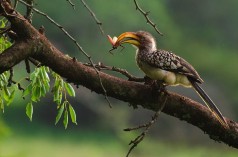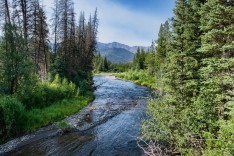The May issue of Methods is now online!
As well as four Application and two Practical Tools articles, the latest issue of Methods in Ecology and Evolution includes six Featured Articles handpicked by our editors – you can find out more about them below.
Featured Articles
Tree-based inference of species interaction networks from abundance data
To be relevant, any network inference methodology needs to handle count data and to account for possible environmental effects. It also needs to distinguish between direct interactions and indirect associations, and graphical models provide a convenient framework for this purpose. A new method from Momal et al. meets these requirements and compares well with state-of-the-art approaches, even when the underlying graph strongly differs from a tree.
Modifying twisted nematic LCD screens to create dichromatic visual stimuli with LEDs – Practical Tools
Didion et al. present a cost-effective way of modifying a twisted nematic LCD screen that utilises coloured LEDs, that allows measuring animals’ sensitivity to, and discrimination between, wavelengths of light. It has the benefit of not requiring a-priori knowledge of animals’ photoreceptor classes. This technique overcomes many of the limitations of RGB-based LCD screens in a cost-effective way, and allows more accurate testing of the role of colour in visually guided behaviours.
moveVis: Animating movement trajectories in synchronicity with static or temporally dynamic environmental data in r – Application – Available Open Access
moveVis automates the processing of movement and environmental data to turn them into an animation. This includes (a) the regularisation of movement trajectories enforcing uniform time instances and intervals across all trajectories, (b) the frame-wise mapping of movement trajectories onto temporally static or dynamic environmental layers, (c) the addition of customisations, for example, map elements or colour scales and (d) the rendering of frames into an animation encoded as GIF or video file.
 A simple, reliable method for long-term, in-stream data logger installation using rock-climbing software – Practical Tools
A simple, reliable method for long-term, in-stream data logger installation using rock-climbing software – Practical Tools
Long-term deployment of in-stream data loggers provides valuable information about stream conditions, particularly in times when streams are difficult to sample manually. Fogg et al. present a method for data logger installation in streams using rock-climbing hardware that is simple to assemble, economical and minimally invasive.
Exploring density- and frequency-dependent interactions experimentally: An r program for generating hexagonal fan designs – Application
Species interactions and diversity are strongly impacted by local processes, with both the density of a focal species and its frequency in the community being important. Hexagonal fan designs can include a range of both densities and frequencies in a single plot, providing large economies in space and material. Rozins et al. present an R program whereby the user can rapidly view a variety of designs and determine the configurations that work best with their space and material constraints.
Multi-species occupancy models as robust estimators of community richness Understanding patterns of diversity is central to ecology and conservation, yet estimates of diversity are often biased by imperfect detection. Tingley et al. use both simulations and an empirical dataset to evaluate bias, precision, accuracy and coverage of estimates of N from multi-species occupancy models compared to the widely applied iChao2 non-parametric estimator.
Application and Practical Tools articles
We’ve got four Application and two Practical Tools articles in this month’s issue of Methods in Ecology and Evolution. Four of them have been covered in our Featured Articles above, so here are the other two:
Climate change research often relies on downscaled general circulation models (GCMs) to project future climate scenarios. As more than 35 GCMs are available at a resolution of 10km and finer, methods are needed to choose which GCM projection is appropriate to use for a region of interest. GCM compareR is a new open-source web app for comparing GCMs, allowing the informed selection from the range of available projections by researchers and policy makers.
AragoJ – A free, open-source software to aid single camera photogrammetry studies Close-range photogrammetry retrieves quantitative information about objects using photography. While software options for extracting information from 3D reconstructions exists, tools for 2D images are scarce, often tailored to specific applications. AragoJ is an open-source software, designed to integrate all steps in 2D close-range photogrammetry in a single program.
The flower on the cover

This issue’s cover shows an experimental array of Silene latifolia flowers, used to study the spread of the anther‐smut pathogen, Microbotryum lychnidis‐dioicae. The array contains a mixture of healthy and diseased flowers, where the influence of the pathogen is to replace the pollen with dark‐colored fungal spores that are conspicuous against the white flower background. Pollinators then pick up and distribute the spores during normal foraging visits.
In their article, Rozins et al. address the difficulty in designing experimental arrays that examine species interactions with a combination of density and frequency‐dependent effects. In addition to such vector‐borne disease transmission, local competition within plant communities are strongly influenced by density and frequency‐dependent responses to species composition and abundance. The authors demonstrate the merit of radial hexagonal fan designs over more traditional systematic grid arrays. To facilitate experimental studies and to ease implementation, they present an R program whereby the user can rapidly view a variety of designs and determine the configurations that work best with their space and material constraints. Photo credit: ©Michael E. Hood, Amherst College
To keep up to date with Methods newest content, have a look at our Accepted Articles and Early View articles, which will be showing up in issues later this year.

